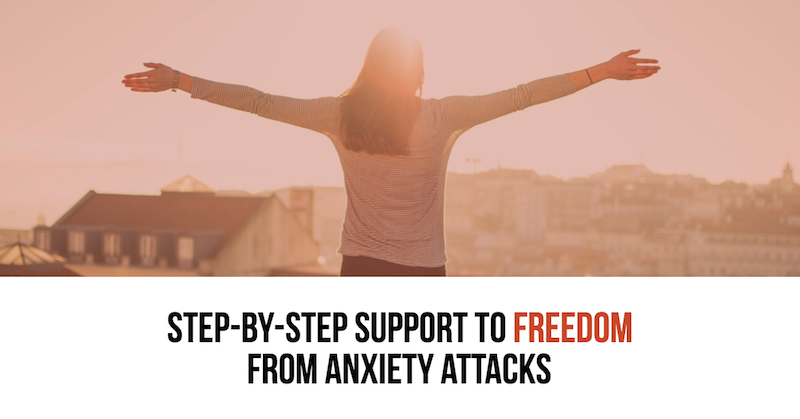415: Breaking Free from the Anxiety Trap

Download this episode (right click and save)
In this episode, we’re introducing our brand new Anxiety Slayer First Responder Series Course created to help our listeners who suffer from debilitating Anxiety Attacks along, with a conversation about how you can break free of the Anxiety Trap.
Before we started creating this course, we asked our listeners and social media following about their biggest challenges with anxiety attacks and the three concerns we heard the most was: the fear of an attack, not knowing the cause, and managing or controlling anxiety attacks.
In the First Responder Series, we will be responding to these three challenges with step-by-step teachings, tools and techniques to help you overcome anxiety attacks and reclaim your life.
Anxiety Attacks and Your Early Warning System
Anxiety Attacks feel like we’re in danger, and set alarm bells ringing in the body as the symptoms of high anxiety kick in.
- fast heart
- shallow breathing
- feeling terrified
- feeling faint
- nausea
- shaking
The symptoms of an anxiety attack are so real and debilitating that many people end up calling an ambulance.
And that intensity of the experience is one of the key triggers of future episodes. One way of thinking of a first anxiety attack is to understand it as a significant traumatic event. An anxiety attack is usually the result of accumulated anxiety, often beneath the level of our conscious awareness. Stress and anxiety build and eventually overflow like a volcanic eruption as a significant event that is very real and shocking.
Future anxiety attacks could be considered a form of post-traumatic stress - a highly stressed response to an event that has caused extreme fear.
Anxiety attacks are traumatic and trauma needs and processing and healing.
Anxiety and Fight, Flight or Freeze
An anxiety attack sets off our fear responses of fight, flight or freeze. But there is no snarling dog to run from or stalker in a dark alley, there’s no car wreck or evidence of injury.
There is nothing visible to fight, escape or face in frozen terror. Yet anxiety attack sufferers are familiar with one, or all, of these responses to the intense physical fear experienced during an anxiety attack.
A fear felt in the body is just as real as the stress of being in an accident, or a violent confrontation. It feels as real, but there’s nothing to see.
Anxiety, for me, is a full body response where my body becomes so confused it doesn’t know how to respond. It is a response my body has to an external or sometimes internal trigger. Anxiety is not just in my mind. It is in my body. - Yujia Ding: The Mighty
This invisible terror adds two extra factors to the already frightening experience of anxiety attacks;
- there’s no apparent cause and effect, so it’s difficult to know how to process or recover from attacks
- that due to that invisibility factor we, and others, might start questioning our sanity
Anxiety Isn’t all in Your Head
Ayurveda - India’s Ancient Science of Life - teaches that our mind runs throughout our body via channels called the manovaha srotas these channels of thought carry the energy and sensations of thought throughout our body. Traditional Psychology and Energy Psychology also teach that anxiety isn’t in our head, it’s in our nervous system. Knowing this can help us regard our experience with greater self-compassion and less concern over losing our minds.
How the Anxiety Trap works
The first episode of an anxiety attack is usually experienced as the effects of an extreme surge of adrenaline. There is always a trigger, but we’re generally utterly unaware of it, so anxiety feels like it struck randomly with no known cause.
Because we have no sense of cause and effect, we might panic. We lose confidence in our ability to cope with anxiety, and that fear releases more adrenaline, enough to power us to fight or run far away from this frightening event. But we have nowhere to run because the trigger is invisible and internal. It’s in us.
Now we are at risk of losing trust in ourself and the “what if” thoughts start. “What if this happens at work, on the train, or on a date?” “What if I can’t cope?” “What if I pass out?” “What if I’m losing my mind?”
This added stress causes the production of yet more adrenaline and more anxiety.

Looking Ahead for Danger
After any frightening experience, the mind is programmed to search ahead for clues that it might happen again. That’s how a phobia is triggered.
After an anxiety attack, the mind becomes sensitised to any physical sensation that feels remotely like an attack. Fast breathing, elevated heart rate, feeling hot or sweating, whatever you felt during an attack your mind will now be looking for. It will also have noted the location and environment where you felt so anxious, and it will try and warn you not to go there again.
This is the natural fear response to a traumatic event.
The mind’s increased focus on body sensations that feel like an anxiety attack can quickly and easily create alarm. This hyper-vigilant symptom watching often triggers the very situation it’s trying to warn you about.
As soon as there are signs of stress or elevated adrenaline in your body warning bells start to ring, and the fear story plays instantly: “Oh no! What if I’m having an anxiety attack?”
The anxious mind can provoke an attack by flagging symptoms that might be from exertion, caffeine, or a bad day at work. If it feels like it could be anxiety, your mind can turn it into anxiety.
This gets even more embedded as a fear response when we repeatedly experience anxiety in certain situations, especially when we are away from home, the mind will then begin to flag these situations because it believes that they are not safe and are, in some way we can’t see, responsible for our anxiety.
This is why many anxiety attack sufferers fear leaving their home in case they experience an attack while out shopping, socialising, driving or at work.
How Supported Action Leads to Freedom
Understanding that the anxiety reaction can be provoked by any physical symptom or location that has been flagged as dangerous gives some understanding of why anxiety attacks can fire off apparently randomly.
The key to breaking free from the anxiety attack cycle is in calming and supporting the thoughts and triggers that provoke the attacks. That support needs to be thorough, and to cover anxiety from different angles; the symptoms, the fear of the fear and learning how to stop an attack in its tracks - and that is what you will learn in this course.
Over the last nine years, we've uncovered the biggest challenges people face with anxiety attacks. The three concerns we hear most include the fear of an attack, not knowing the cause of an attack, and managing anxiety.
In our new course: Anxiety Slayer First Responder Series - Anxiety Attacks, we respond to these three challenges with step-by-step teachings, tools, and techniques to help you overcome anxiety attacks.
This supportive online course is for you if you're ready to STOP Anxiety Attacks and Reclaim Your Life and as a special introductory offer to all our listeners, you can save $20 on the full course price when you enrol before Monday, October 1st.

